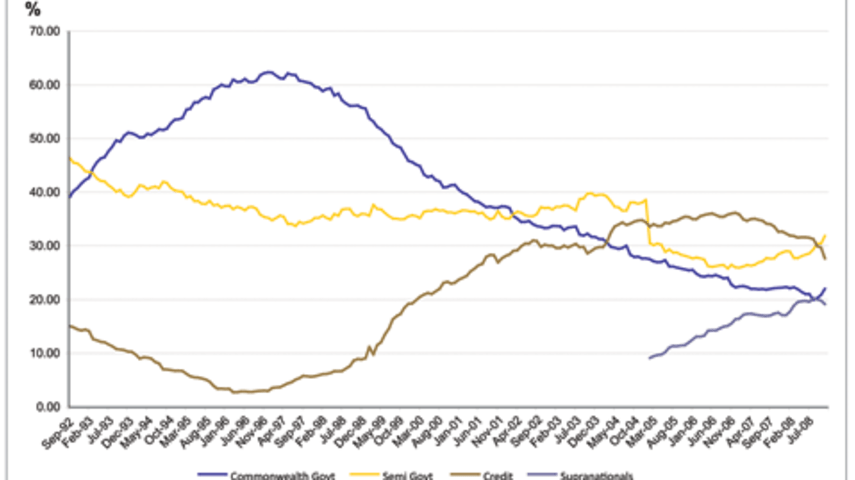Asking the right questions about bonds



Two main drivers have led to major changes in the bond market since the global financial crisis began.
First, there is the impact of the Government bond issuance that has taken place over the past 12 months, and second, the attitudes of investors towards risk and returns.
Government issuance
The growth in Government Budget deficits — resulting from the need to fund various stimulus packages — has led to a huge increase in the issue of Government securities.
The Commonwealth Government is currently issuing between $500 million and $700 million of Government bonds via two tenders each week.
In contrast, securities issued by corporations (ie, credit) have decreased dramatically, as they de-leverage and reduce debt.
As a result, the bond market now has a very different structure to that of just two years ago.
The composition of the UBS Composite Bond Index, in terms of the balance between corporate and government securities, is starting to look very much as it did in the late 1990s and early 2000s.
Commonwealth and government-guaranteed securities are expected to make up around 45 per cent of the index in the next few years (after falling to around 20 per cent in 2008
as seen in Chart 1) and corporate bonds are set to fall to around 25 per cent (after reaching 36 per cent in 2006).
However, when the economy starts to stabilise, it will be the turn of the Government to reduce debt, and it is likely that the supply will become dominated by the banks, particularly the four majors.
Most probably, structured debt will make a return to satisfy demand, although to start with, it will need to be of extremely high quality if it is to attract investors.
Risk and return
In addition to a marked change in the index’s composition, the expected risk and return is also changing.
A major development in the bond market over the past 15 years has been the changed risk landscape, directly affecting how investors behaved.
In the late 1990s and early 2000s, the decline in government debt and low economic volatility led to a repricing of risk. Investors had greater confidence about the future of the economy, particularly inflation, and therefore were more comfortable investing over the longer term. This resulted in a decline in term risk.
However, this resulted in a flight to risk from investors demanding higher yields. Investors not only turned their focus to corporate bonds but were also willing to use leverage to increase returns.
Because of the strong demand for corporate bonds, which was not being matched by supply, spreads declined to the point where the returns covered very little of the risks inherent in these securities, particularly those rated BBB and lower.
The problem was that, in the hunt for greater returns in a low yield environment, many investors mistook the higher returns provided by credit as alpha, when it really was just greater risk.
This is now in reverse, with returns now most likely to be achieved by taking on term risk rather than credit risk.
However, returns from fixed income portfolios may be lower than the equity-like returns investors have experienced in the recent past from credit-focused funds.
Diversification will also come back into vogue as investors re-discover the benefits of investing both across and within asset classes — in particular, holding more defensive fixed income securities (government bonds), which generally increase in value when equity markets fall.
Some other significant changes to fixed interest include:
- an increase in term premiums. In order to be compensated for holding longer-term investments, investors are demanding higher yields on government securities, and so for the first time since 2005, there has been a steepening of the yield curve (as shown in Chart 2). With cash rates at 3 per cent and the yield to maturity on 10-year bonds rising to over 5 per cent, term assets are much more attractive relative to cash (despite the uncertainty surrounding the economy, inflation and future cash rate movements).
- a possible increase in duration. There is likely to be an increase in the duration of the UBS Composite Bond Index. The average modified duration of the index has fallen from 3.9 years in 1997 to around 3.2 years at the end of July 2009. Much of this was due to the increase in credit securities in the index. As credit securities generally have maturities of five years or less, they tend to have a shorter duration than government paper. However, as the supply of government paper increases, the modified duration for the index is also likely to increase.
- a decline in credit issuance. Research by UBS suggests that by June 2013 the number of securities outstanding will be around $710 billion (up from $300 billion currently) and only 27 per cent will be non-government debt. There has been virtually no credit securities issued by non-financial institutions between 2007 and 2009, and the decline will only accelerate because of the upcoming maturities, particularly those due before the end of 2009.
Banks will be the primary source of non-government issuance.
Domestic corporate issuers have baulked at the cost of borrowing from the fixed income market since 2007, and capital raisings between 2007 and 2009 have largely been via bank debt or equity issuance.
Non-financial institutions value diversity of funding and this will not be achieved if they rely purely on the banks or equity raisings for increased capital.
The bond market will therefore need to accommodate some issuance. However, this domestic supply source is likely to be too small to satisfy investors.
Additionally, the credit ratings on these securities will not be high. Investors are now more wary about investing in lower-quality securities as illustrated by the widening of the credit spreads between BBB and AAA-rated (Chart 3).
After the events of last year and looking at future supply, fixed income funds are likely to assume a much more conservative profile, with government securities featuring as a larger percentage in the asset allocation mix than they did in recent times.
Roger Bridges is head of fixed income at Tyndall/ Suncorp Investment Management.
Recommended for you
Melbourne advice firm Hewison Private Wealth has marked four decades of service after making its start in 1985 as a “truly independent advice business” in a largely product-led market.
HLB Mann Judd Perth has announced its acquisition of a WA business advisory firm, growing its presence in the region, along with 10 appointments across the firm’s national network.
Unregistered managed investment scheme operator Chris Marco has been sentenced after being found guilty of 43 fraud charges, receiving the highest sentence imposed by an Australian court regarding an ASIC criminal investigation.
ASIC has cancelled the AFSL of Sydney-based Arrumar Private after it failed to comply with the conditions of its licence.











